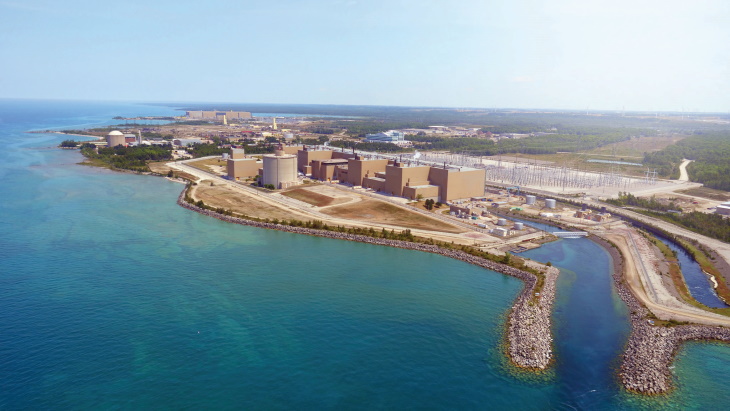Study highlights Bruce plant's emergency preparedness
Measures put in place at Canada's Bruce nuclear plant in the 10 years since the Fukushima Daiichi accident in Japan have made the site safer, stronger and better prepared to deal with even the most unlikely emergency, a new study has concluded. Emergency preparedness enhancements mean that off-site protective actions would not be required even in the most unlikely situation, the study by Kinectrics has found.

The Bruce reactors on the shore of Lake Huron (Image: Bruce Power)
The 2011 accident occurred when a major earthquake was followed by a 15-metre tsunami, which disabled the power supply and cooling of three reactors at Fukushima Daiichi. In response, the world's nuclear plants - including those owned by Bruce Power - underwent thorough reviews and made upgrades and changes to ensure lessons learned were captured.
Bruce Power implemented a wide range of enhancements to improve the capability of its plants to respond to an extended loss of AC power caused by a natural disaster, including: the provision of equipment for use in emergency mitigation; the installation of passive autocatalytic recombiners to mitigate the potential for hydrogen to accumulate inside containment; and the installation of shield tank overpressure protection, which removes the need for radiological venting to the environment during a severe accident. The company says it has spent "tens of millions" on these enhancements.
Bruce Power commissioned Toronto-based Kinectrics to carry out the study to support Bruce's inputs to the Province of Ontario Office of the Fire Marshal and Emergency Management (OFMEM), as it prepares to revise its Provincial Nuclear Emergency Response Plan (PNERP). The PNERP was updated in 2017 to include lessons learned from Fukushima. OFMEM plans next year to issue a revised PNERP to reflect industry developments and lessons learned since the last update.
Kinectrics' study analyses the consequences for a range of potential but highly unlikely accident scenarios: a large loss of coolant accident (LOCA) on a single unit where various safety systems function as designed; a LOCA on a single unit which progresses to a severe accident (SA) as a result of the failure of the emergency coolant injection system and a loss of moderator cooling; and a station blackout which results in a loss of AC power to all four units that progresses to a SA. These representative scenarios encompass the range of accidents considered in the PNERP planning basis.
"In all cases, the estimated off-site doses are sufficiently low such that it is not anticipated off-site protective actions would be required," the report notes. "This illustrates the effectiveness of various post-Fukushima enhancements Bruce Power has implemented to mitigate the consequences of BDBAs [beyond design basis accidents]. Furthermore, the results of the analysis indicate that the existing emergency planning zones are more than adequate to manage the off-site response to representative accident scenarios which form the PNERP planning basis. The existing emergency planning zones ensure there is margin available to manage the off-site response to very low probability, higher consequence SAs which have the potential to result in the need for off-site protective actions."
Bruce Power's eight Candu units, on the shores of Lake Huron, annually produce 30% of Ontario's electricity.
Researched and written by World Nuclear News
- China Institute of Atomic Energy
- Nuclear Power Institute of China
- Southwestern Institute of Physics
- China Nuclear Power Operation Technology Corporation, Ltd.
- China Nuclear Power Engineering Co., Ltd.
- China Institute for Radiation Protection
- Beijing Research Institute of Uranium Geology (BRIUG)
- China Institute of Nuclear Industry Strategy (CINIS)
- China Nuclear Mining Science and Technology Corporation


